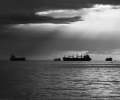West of Suez – Freight rates seen strengthening in fourth quarter

With the winter market approaching, creating market inefficiencies, coupled with rising oil demand, expectations for stronger freight rates in the fourth quarter gather pace.
Although dirty tanker freight rates were steady through most of the third quarter, towards the end of September they started to increase. VLCC rates reached $12.66/mt on the West Africa-to-East 260,000 mt run, the highest figure recorded so far in 2021, supported by a strong US Gulf and East Coast Mexico market. Aframax rates, on the other hand, moved to $8.99/mt for a Black Sea-to-Mediterreanean 80,000 mt run, against the quarter’s average of $7.91/mt, backed by the biggest Urals and CPC loading programs since April and May 2020, respectively.
After a prolonged period of depressed tanker rates, owners are hoping to see rates rising by year end.
The imbalance in vaccinations recorded between the West and East had led to an uptick in COVID-19 cases recorded in Asia and the re-imposition of lockdowns in some countries. According to S&P Global Platts Analytics, East of Suez’s contribution to global demand growth in the third quarter was lower quarter on quarter, with growth driven mostly by west of Suez countries. In the fourth quarter though, Asian demand is projected to be much stronger.
Output disruptions in West Africa
VLCC rates from West Africa to the Far East averaged $10.39/mt in the third quarter, from $13.65/mt in Q3 2020, or down 24% year on year, with crude output from Angola and Nigeria on a downward trajectory so far this year. According to S&P Global Platts estimates, Angolan crude output has been at multi-year lows through much of 2021, averaging 1.13 million b/d, due to operational and technical issues at some fields and a lack of investment in the last five years. This represents a 40% decrease across the past five years, with the government, however, aiming to stabilize its oil production at 1.3 million b/d over the next three years. OPEC+ has been struggling to meet its current production quotas, squeezing supply in the oil market. According to the International Energy Agency, output in August was 860,000 b/d lower than agreed levels, with Angola and Nigeria pumping 560,000 b/d.
High crude oil prices erode vessels’ earnings
Global output disruptions, inventory drawdowns and an oil demand rebound have resulted in increasingly high crude oil prices, with Brent breaking the $80/b mark, according to Platts data. Consequently, high bunker prices have greatly affected shipowners’ balance sheets, with some routes producing negative cashflows. The spread between high sulfur fuel oil and very low sulfur fuel oil delivered in Singapore has averaged $109/mt so far in 2021, with scrubber-fitted ships having a comparable advantage over VLSFO-fueled vessels. With non-scrubber-fitted ships being unprofitable at current market levels for long haul voyages, most vessels ballasting West are scrubber-fitted. Thus, should bunker prices remain high, tonnage supply in the Atlantic and Pacific basin will only see marginal changes.
Hurricane Ida, one of the worst storms that has ever hit the US Gulf Coast, on Aug. 29 shut down 1.7 million b/d of oil production, which according to the IEA could mean a total crude supply loss of up to 30 million barrels. With the crude market structure in backwardation since the beginning of the year, there has been a significant drawdown of global inventories and reduced demand for floating storage, putting pressure on the tanker markets. At the same time, record high natural gas prices are very likely to encourage a gas-to-oil switch, with the IEA estimating 150,000 b/d to 200,000 b/d of additional oil demand from between the third quarter of 2021 and first quarter of 2022. The tightness of the oil market and record high natural gas prices are likely to support high crude oil prices in the near-term, putting pressure on tanker owners’ earnings.
Should talks between the US and Iran continue in the fourth quarter and a nuclear deal comes to fruition, the tanker market will not only benefit from an additional 1.7 million b/d of oil entering the market but also from the fact that vessels that have been lifting Iranian sanctioned oil will have to get scrapped. Despite scrap prices being at a 13-year high and freight rates hovering around bottom levels through much of this year, scrapping has been much lower than expected. At the same time, high steel prices and strong orderbooks recorded in other shipping segments have also caused tanker newbuilding prices to rise, shaping a clear disconnection between asset values and freight rates.
Source: Platts

 Hellenic Shipping News Worldwide Hellenic Shipping News Worldwide, Online Daily Newspaper on Hellenic and International Shipping
Hellenic Shipping News Worldwide Hellenic Shipping News Worldwide, Online Daily Newspaper on Hellenic and International Shipping






















 PG-Software
PG-Software